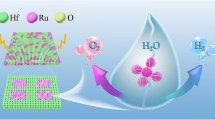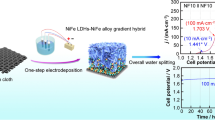Abstract
Distinct three-dimensional hierarchically stacking SnO2-Sb/TiO2-NTs electrode with a good-adhesion TiO2-NTs@SnO2-Sb interlayer, a compact plate SnO2-Sb middle layer, and an apparent uniform microsphere layer was successfully prepared through the hydrothermal method. The evolution of micro-morphology and structure of electrode catalyst layer was realized so as to improve the catalytic performance of electrode through tuning the hydrochloric acid concentration. Experimental results show that SnO2-Sb/TiO2-NTs electrode prepared in 0.5 mol L−1 HCl condition possesses the optimal performance containing a low phenol oxidation potential of 1.2 V (vs. SCE), and a maximum current density of 3.8 mA cm−2 towards phenol degradation in phosphate buffered solution. The electrochemical phenol removal results show that the phenol degradation process coincides with the first-order kinetics and the corresponding optimal constant reaches 14.2 × 10−3 min−1. The TOC removal efficiency of optimal electrode reaches 62%.

Graphical abstract
The evolution of micro-morphology and structure of electrode was realized through tuning the hydrochloric acid concentration so as to improve the catalytic performance of electrode.






Similar content being viewed by others
References
Martínez-Huitle CA, Rodrigo MA, Sires I, Scialdone O (2015) Single and coupled electrochemical processes and reactors for the abatement of organic water pollutants: a critical review. Chem Rev 115(24):13362–13407
Panizza M, Cerisola G (2009) Direct and mediated anodic oxidation of organic pollutants. Chem Rev 109(12):6541–6569
Chaplin BP (2014) Critical review of electrochemical advanced oxidation processes for water treatment applications. Environ Sci Proc Impacts 16(6):1182–1203
Chen G (2004) Electrochemical technologies in wastewater treatment. Sep Purif Technol 38(1):11–41
Rao ANS, Venkatarangaiah VT (2014) Metal oxide-coated anodes in wastewater treatment. Environ Sci Pollut R 21:3197–3217
Wu W, Huang Z-H, Lim T-T (2014) Recent development of mixed metal oxide anodes for electrochemical oxidation of organic pollutants in water. App Catal A-Gen 480:58–78
Christensen PA, Zakaria K, Christensen H, Yonard T (2013) The effect of Ni and Sb oxide precursors, and of Ni composition, synthesis conditions and operating parameters on the activity, selectivity and durability of Sb-doped SnO2 anodes modified with Ni. J Electrochem Soc 160(8):H405–H413
Duan T, Chen Y, Wen Q, Duan Y (2014) Enhanced electrocatalytic activity of nano-TiN composited Ti/Sb–SnO2 electrode fabricated by pulse electrodeposition for methylene blue decolorization. RSC Adv 4(101):57463–57475
Duverneuil P, Maury F, Pebere N, Senocq F, Vergnes H (2002) Chemical vapor deposition of SnO2 coatings on Ti plates for thepreparation of electrocatalytic anodes. Surf Coat Technol 151-152:9–13
Montero J, Guillén C, Herrero J (2012) Nanocrystalline antimony doped tin oxide (ATO) thin films: a thermal restructuring study. Surf Coat Technol 211:37–40
Xu H, Zhang Q, Yan W, Chu W (2011) A composite Sb-doped SnO2 electrode based on the TiO2 nanotubes prepared by hydrothermal synthesis. Int J Electrochem Sc 6:6639–6652
Huang AS, Zhao GH, Li HX (2007) High quality Sb-doped SnO2 electrodes with high oxygen evolution potential prepared by in situ hydrothermal synthesis method. Chin Chem Lett 18(8):997–1000
Cui X, Zhao G, Lei Y, Li H, Li P, Liu M (2009) Novel vertically aligned TiO2 nanotubes embedded with Sb-doped SnO2 electrode with high oxygen evolution potential and long service time. Mater Chem Phys 113(1):314–321
Zhao G, Cui X, Liu M, Li P, Zhang Y, Cao T, Li H, Lei Y, Liu L, Li D (2009) Electrochemical degradation of refractory pollutant using a novel microstructured TiO2 nanotubes/Sb-doped SnO2 electrode. Environ Sci Technol 43(5):1480–1486
Guo Y, Duan T, Chen Y, Wen Q (2015) Solvothermal fabrication of three-dimensionally sphere-stacking Sb-SnO2 electrode based on TiO2 nanotube arrays. Ceram Int 41(7):8723–8729
Li Y, Shen W (2014) Morphology-dependent nanocatalysts: rod-shaped oxides. Chem Soc Rev 43(5):1543–1574
Xia Y, Xiong Y, Lim B, Skrabalak SE (2009) Shape-controlled synthesis of metal nanocrystals: simple chemistry meets complex physics? Angew Chem Int Ed 48(1):60–103
Peralta E, Roa G, Hernandez-Servin JA, Romero R, Balderas P, Natividad R (2014) Hydroxyl radicals quantification by UV spectrophotometry. Electrochim Acta 129:137–141
Harris D C (2007) Quantitative chemical analysis, 7th ed., W. H. Freeman and Company
Duan T, Ma L, Chen Y, Ma X, Hou J, Lin C, Sun M (2018) Morphology-dependent activities of TiO2-NTs@Sb-SnO2 electrodes for efficient electrocatalytic methyl orange decolorization. J Solid State Electrochem 22(6):1871–1879
Yang L, Liu J, Huang L, Zhang Z, Yu Y, Liu J, Logan BE, Feng Y (2018) Fabrication of nano-structured stacked sphere SnO2-Sb electrode with enhanced performance using a situ solvothermal synthesis method. J Electrochem Soc 165(5):E208–E213
Bai F, He Y, He P, Tang Y, Jia Z (2006) One-step synthesis of monodispersed antimony-doped tin oxide suspension. Mater Lett 60(25-26):3126–3129
Nütz T, Haase M (2000) Wet-chemical synthesis of doped nanoparticles: optical properties of oxygen-deficient and antimony-Ddoped colloidal SnO2. J Phys Chem B 104(35):8430–8437
Sladkevich S, Mikhaylov AA, Prikhodchenko PV, Tripol’skaya TA, Lev O (2010) Antimony tin oxide (ATO) nanoparticle formation from H2O2 solutions: a new generic film coating from basic solutions. Inorg Chem 49(20):9110–9112
Meng X, Zhang Y, Sun S, Li R, Sun X (2011) Three growth modes and mechanisms for highly structure-tunable SnO2 nanotube arrays of template-directed atomic layer deposition. J Mater Chem 21(33):12321–12330
Gorlin Y, Jaramillo TF (2010) A bifunctional nonprecious metal catalyst for oxygen reduction and water oxidation. J Am Chem Soc 132(39):13612–13614
Mamtani K, Jain D, Dogu D, Gustin V, Gunduz S, Co AC, Ozkan US (2018) Insights into oxygen reduction reaction (ORR) and oxygen evolution reaction (OER) active sites for nitrogen-doped carbon nanostructures (CNx) in acidic media. Appl Catal B-Environ 220:88–97
Chen Y, Hong L, Xue H, Han W, Wang L, Sun X, Li J (2010) Preparation and characterization of TiO2-NTs/SnO2-Sb electrodes by electrodeposition. J Electroanal Chem 648(2):119–127
Duan T, Wen Q, Chen Y, Zhou Y, Duan Y (2014) Enhancing electrocatalytic performance of Sb-doped SnO2 electrode by compositing nitrogen-doped graphene nanosheets. J Hazard Mater 280:304–314
Loloi M, Rezaee A, Aliofkhazraei M, Rouhaghdam AS (2016) Electrocatalytic oxidation of phenol from wastewater using Ti/SnO2-Sb2O4 electrode: chemical reaction pathway study. Environ Sci Pollut Res 23(19):19735–19743
Martínez-Huitle CA, Ferro S (2006) Electrochemical oxidation of organic pollutants for the wastewater treatment: direct and indirect processes. Chem Soc Rev 35(12):1324–1340
Author information
Authors and Affiliations
Corresponding authors
Additional information
Publisher’s note
Springer Nature remains neutral with regard to jurisdictional claims in published maps and institutional affiliations.
Rights and permissions
About this article
Cite this article
Gao, X., Duan, T., Ma, L. et al. Morphology evolution effects on electrochemical activity of hierarchically stacking SnO2-Sb/TiO2-NTs electrode prepared by the hydrothermal method. J Solid State Electrochem 23, 1289–1296 (2019). https://doi.org/10.1007/s10008-019-04229-1
Received:
Revised:
Accepted:
Published:
Issue Date:
DOI: https://doi.org/10.1007/s10008-019-04229-1




